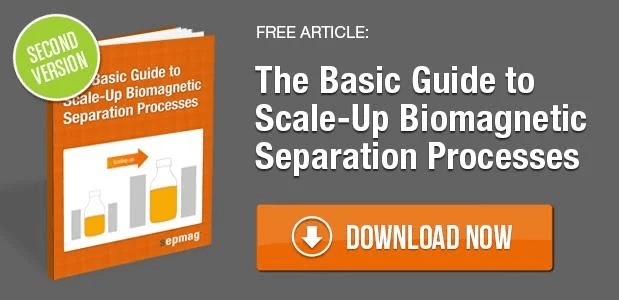There are many variables to consider when designing a magnetic separation system and tailoring it to the experimental goal. Bead surface functionalization is one key component, and often receives the most attention because it is the most obvious point of control for assay specificity. However, it is easy to lose site of the fundamental mechanics of magnetic separation. When designing a magnetic separation protocol it is also important to consider the movement of the magnetic particles in the magnetic field gradient. Superparamagnetic particles will form chains when placed into a magnetic field, a key property to have high enough separation speed for practical purposes.
Factors that govern aggregation behavior of paramagnetic beads
- Magnetic interaction between particles: In the absence of an external magnetic field superparamagnetic beads are not magnetic, i.e. its magnetic moment is zero. When they are placed into a magnetic field the magnetic material in each particle is magnetized and acquires magnetic moment. This magnetic moment will interact with neighboring magnetized particles and they can also attract or repel each other, exactly as two small magnets do. Chain-like structures of magnetic particles form when the magnetized individual particles are aligned in the magnetic field if the magnetic interaction overcome thermal fluctuations. The strength of the interaction between superparamagnetic particles will increase with applied magnetic field strength, as at low field the magnetic moment is proportional to it (constant susceptibility). After a certain value of the applied magnetic field (saturation field), the magnetic moment reaches a maximum value and remains constant. If the applied magnetic field is removed, all the particle lose the magnetic moment and the chains are dissolved by the thermal fluctuations.Only if the particles are not superparamagnetic, the particles have a remanent magnetic moment and the chained aggregation can survive without applied magnetic field or other mechanism that keep the particles together.
- Concentration of beads in solution:The chain aggregation of magnetic particles is more likely to occur when there is a higher concentration of particles in solution, as the magnetic interaction between particles will be stronger due the shorter distance to its neighbours. If the concentration of particles in solution is further increased or if the applied magnetic field is further enhanced then the one-dimensional chains may begin to interact to form bundles.
Aggregation of magnetic beads is undesirable during bead processing steps
Aggregation of magnetic beads is undesirable if it happens during the processing steps (coating and functionalizing) prior to use in magnetic separation. This irreversible aggregation occurs when the proper protocol is not followed or if the magnetic force used to retain the beads is too high. Note that for classical magnetic separators, the magnetic force decreases with the distance to the retention area and, even if it is very weak -larger separation time- over the farthest beads, the retention force can be extremely high. The new biomagnetic separation systems, however,generates magnetic field profiles able to keep the force constant over the working volume. Thus, the magnetic force is stronger over the farthest beads (faster separation without bead losses), but at the same time the retention force is just the needed to avoid losses when the supernatant is aspirated.
If this specific point is not properly addressed, irreversible aggregated beads are incubated with the target molecule there will be poor binding and the separation will be highly variable.
Gaining more control over magnetic bead aggregation
It is important to consider the effects that bead concentration and magnetic force can have on the aggregation of magnetic particles. Reversible chain-like aggregation are necessary to have practical speeds on the separation process. Small diameter (or low magnetic moment) particles will move individually, having separation speed orders of magnitude slower, with separation times measured in hours/days instead seconds/minutes. But excessive magnetic force (as is the case on the retention area of classical magnetic separators) can be detrimental during early bead-processing stages, as it may generate irreversible aggregates ( ‘clumps’) and hidden some of the surface from exposure to the functional molecule, avoiding its binding. That would lead to higher variability (the functionalized area will depend on the ‘aggregation’ history of the different beads)
Related news





